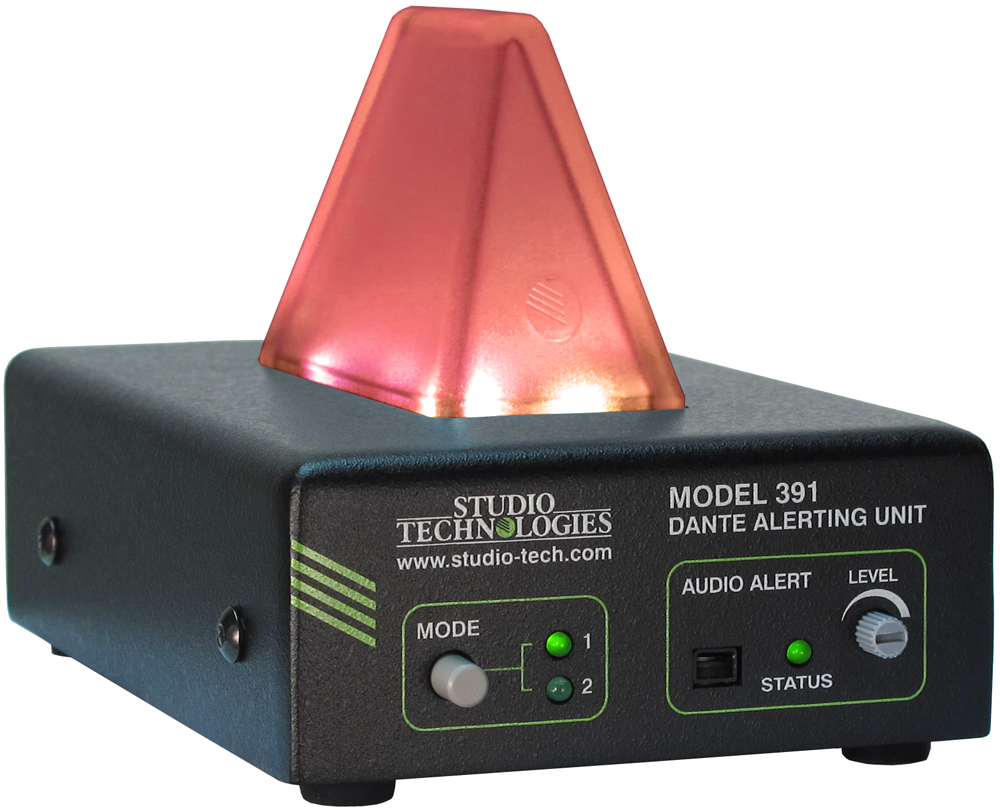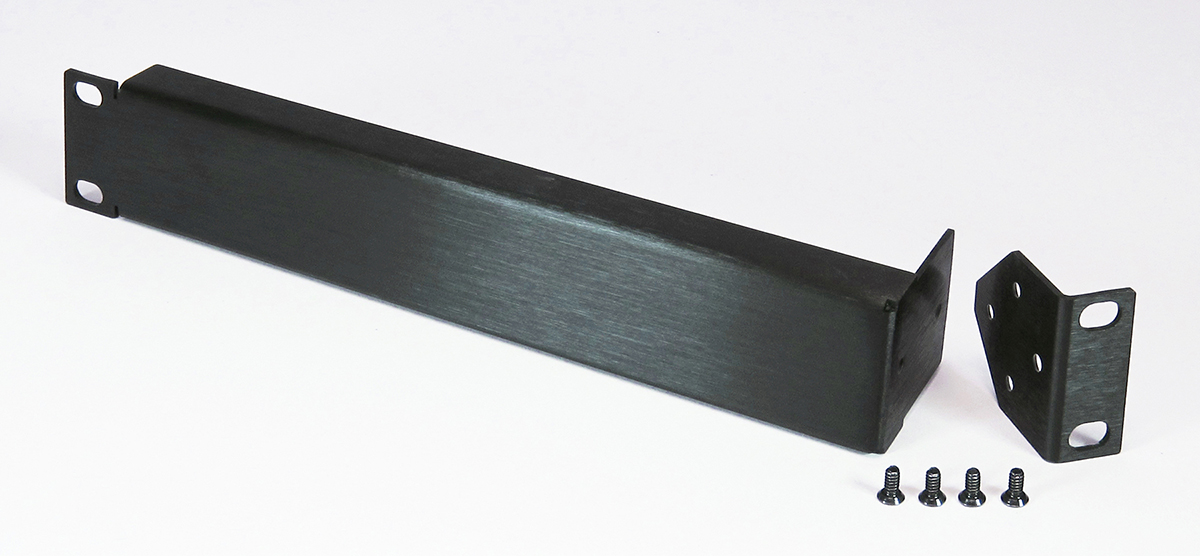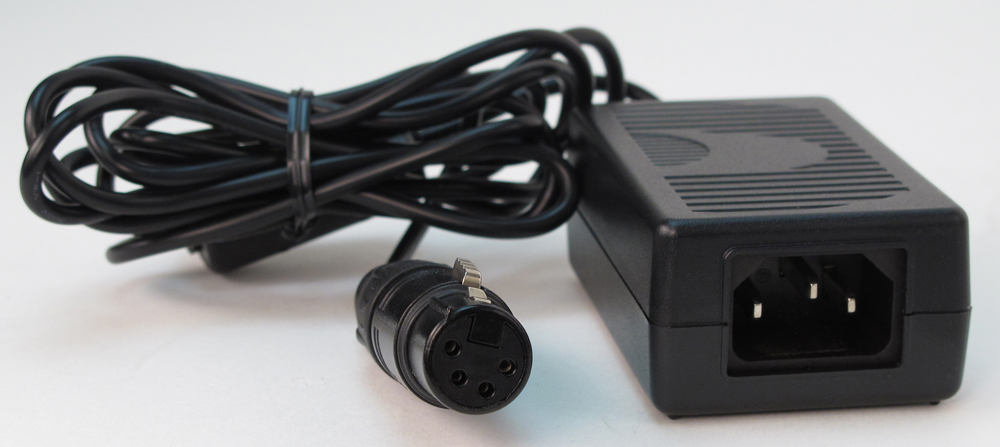The Model 544D Audio Interface provides a simple yet high-performance means of interfacing two channels of analog line-level audio to and from applications that utilize Dante® audio-over-Ethernet media networking technology. Two Model 544D units can provide one-to-one signal paths, two in each direction, over a standard local area network (LAN). A Model 544D can work on its own to allow Dante-enabled products to interface with analog input and output signals. In addition, the unit supports transport of status signals or contact closures between Model 544D units and other compatible products. There are two general-purpose inputs (GPI) and two general-purpose outputs (GPO) on each Model 544D. The Model 544D can also provide a tone generator function. This allows sine-wave signals at a frequency of 1 kHz, 18 kHz, or 20 kHz to be output by way of the analog line-level and Dante digital interface channels.
The Model 544D is a fully professional product that offers the audio quality, features, and reliability required by 24-hour, on-air, and commercial applications. The two line-level analog audio inputs use standard 3-pin female XLR connectors for easy interfacing with balanced and unbalanced sources. The input audio signals are converted to 24-bit digital and then transported via the Dante interface. Two digital audio signals arrive into the Model 544D via the Dante interface and are then converted to analog. Two 3-pin male XLR connectors on the Model 544D's back panel provide balanced analog line-level outputs.
The Model 544D can serve as an analog-to-Dante bridge, linking analog audio interfaces found on devices such as matrix intercom systems, broadcast routers, and audio consoles to and from the Dante domain. An Ethernet connection is all that's required to make the Model 544D part of a sophisticated, networked audio system. Dante audio-over-Ethernet has found wide acceptance as an audio "backbone" due to its ease of use, high performance, strong interoperability, and wide adoption by a large number of equipment manufacturers. The Model 544D is a general-purpose "tool" that helps to expand Dante's capabilities to facilities and equipment that primarily supports signals in the analog domain.
Audio data is sent to the Model 544D using the Dante audio-over-Ethernet media networking technology. Audio signals with a sample rate of 48 kHz and a bit depth of up to 24 are supported. The two line-level input channels are converted to digital and then routed to transmitter (output) channels on the Dante interface. Two transmitter (output) channels from an associated Dante-enabled device can be assigned to the Model 544D's receiver (input) channels using the Dante Controller application. These are then converted into analog outputs.
Careful attention to circuit design and component selection ensures that excellent audio quality is maintained. Extensive filtering helps prevent damage or less-than-optimal performance should DC voltage, ESD ("static"), or strong RF signals be present on the associated analog signals.
The STcontroller software application is used to configure the Model 544D's wide range of operating parameters. These include the nominal signal levels and which sources are utilized for the analog and Dante digital channels. Versions of STcontroller are available that are compatible with the Windows® and macOS® operating systems. They are available, free of charge, from the Studio Technologies' website.
Using STcontroller, the nominal audio levels of the line input and line output functions can be independently selected. In this way, compatibility with SMPTE®, EBU, and "semi-pro" nominal signal levels is supported. Audio level meters provide confirmation of system performance during setup and operation. Two general-purpose input (GPI) and two general-purpose output (GPO) functions allow support for installer-selected applications, including party-line intercom call-light functions. LED indicators provide a direct indication of the status of the GPI and GPO functions.
The Model 544D can be powered by power-over-Ethernet (PoE) or an external source of 12 volts DC. Standard connectors are used for the analog line inputs and analog line outputs, Ethernet, GPI, GPO, and DC power interconnections. The Model 544D's enclosure has a "1/2-rack" 1U form factor and weighs less than two pounds, making it well suited for use in portable applications. Alternately, using one of the optional rack-mount front panels, one or two Model 544D units can be mounted in a single space (1U) of a standard 19-inch rack enclosure.
Applications
The most basic application for Model 544D is for transporting analog audio signals to and from one location to another using the data transport resources of a local area network — there's really no simper means to getting high-quality audio from "point A to point B" and back. With standard connectors and PoE power, setup can be completed in just a few minutes. This makes Model 544D units effective in both fixed and portable applications.
The Model 544D can also find use when an application already supports Dante. For example, ports on a matrix intercom system that directly supports Dante, such as the RTS® ODIN® or ADAM® with OMNEO®, can be routed to a Model 544D's Dante transmitter (output) and receiver (input) channels. The Model 544D will then provide two analog line inputs and two analog line outputs for use in a variety of applications. These can include interfacing with audio inputs and outputs associated with audio consoles, providing talent cueing (IFB) feeds, and interfacing with the audio outputs of aerial camera systems.
The GPI and GPO functions allow Model 544D units to transport contact closures using high-frequency audio tones that are embedded as part of the unit's audio channels. Two independent contact closures can be "repeated" across a network using Dante audio paths. Provided for installer-specified applications, having the ability to transport contact closures over significant distances can be a unique and valuable resource.
The Model 544D's tone generator capability enables the unit to create 1 kHz, 18 kHz, and 20 kHz sine-wave analog and Dante digital audio signals. The ability to generate precision 1 kHz sine-wave tones is intended for general-purpose audio use. The 18 kHz tone is provided as a resource when supporting remote-production (REMI) applications that use the Studio Technologies' Model 5422A Dante Intercom Audio Engine. This 18 kHz tone can be used by a matrix intercom system to facilitate creation of voice-with-tone interruptible foldback (IFB) signals. When routed to Model 5422A interrupt inputs, these specialized IFB interrupt signals will allow creation of excellent talent cueing channels.
The 20 kHz tone option is provided for use in applications where generation of a party-line call signal is desired. For example, the 20 kHz tone can be connected to a matrix intercom system which would be configured such that a button press will cause 20 kHz to be sent out an intercom channel. This can serve as a "trigger" signal for visual or audible alerting devices, such as the Studio Technologies' Model 391 Dante Alerting Unit.
Line Inputs
The Model 544D provides two analog line-level input channels. Two STcontroller configuration choices allow the nominal levels of each input to be +4 dBu, –2 dBu, or –10 dBu. When configured for +4 dBu the unit will be compatible with SMPTE applications where the nominal digital signal level is –20 dBFS. The –2 dBu configuration choice allows the line inputs to be optimized for EBU applications where the nominal digital signal level is –18 dBFS. The –10 dBu configuration is provided for "semi-pro" applications where sources are typically unbalanced (single-ended). Using this selection, an analog signal with a level of –10 dBu will result in a Dante digital output signal with a level of –20 dBFS.
The electronically balanced (differential) input circuits are capacitor-coupled and ESD (static) protected for reliable operation in a variety of applications. They are also protected from damage should a moderate DC voltage be accidentally connected. Sources can include analog I/O cards on matrix intercom systems, audio consoles, wireless microphone receivers, and broadcast routers.
Line Outputs
The Model 544D provides two analog line-level output channels. As with the line inputs, STcontroller choices allow the audio source for each line output to be selected. Choices include the Dante receiver (input) channels, the line inputs, and three sine-wave tone sources. The nominal level of the line outputs can be selected in STcontroller to be +4, –2, or –10 dBu. This allows compatibility in applications where SMPTE (+4 dBu = –20 dBFS) or EBU (0 dBu = –18 dBFS) standards may apply. The –10 dBu setting can be useful for "semi-pro" applications where a lower nominal level is necessary. The line outputs are electronically balanced, capacitor-coupled and ESD (static) protected. The outputs are compatible with virtually all balanced and unbalanced inputs with an impedance of 2 k ohms or greater.
Pro Audio Quality
The Model 544D's audio circuitry was designed in the spirit of professional audio equipment rather than that found in typical broadcast or commercial audio gear. High-
performance components are used throughout, providing low-distortion, low-noise, and high headroom. Care was taken so that signal integrity is maintained in both the analog and digital domains.
Audio Meters and Status LEDs
The Model 544D provides four 5-segment LED meters. The meters, located on the unit's front panel, display the level of the audio signals associated with the two line
inputs and two line outputs. At the time of installation and setup the meters are invaluable in helping to confirm correct operation. During normal operation the meters offer a real-time confirmation of the unit's audio signal levels, helping to ensure that optimal audio quality is maintained. Additional LED indicators are provided on the front panel, offering status indications of the incoming power, GPI, and GPO functions.
GPI and GPO Capability
The Model 544D allows the sending and receiving of status signals using high-frequency audio tones that are transported within the Dante audio channels. When two Model 544D units are interconnected using an Ethernet network and Dante, two status signals can be transported in each direction. The GPI (general-purpose input) functions are compatible with contact closures provided by equipment such as matrix intercom systems, video/audio routers, or tally systems. During operation, a closure on one Model 544D GPI will result in the closing (shorting) of a solid-state relay contact associated with the GPO on a second Model 544D unit. To assist in implementing specialized GPI and GPO applications a source of low-current DC power is also provided.
The GPI and GPO functions can be especially useful in party-line intercom applications where call-light signals are utilized. Contact closures on matrix intercom systems can be "repeated" by Model 544D units that are located anywhere on the same local area network (LAN). The Model 544D is also directly compatible with the call-light signal support provided by the Studio Technologies' Model 545DC and Model 545DR Intercom Interface units. With a Model 544D appropriately interconnected with a matrix intercom system full call-light support can be provided to and from RTS and Clear-Com® party-line intercom circuits.
Tone Generator Mode
For special applications, the Model 544D can be configured to serve as an audio tone generator. Instead of functioning as an interface device, the Model 544D will generate low-distortion, frequency-accurate, sine-wave audio signals. STcontroller configuration choices allow the frequency of the tones to be 1 kHz, 18 kHz, or 20 kHz. The tone signals are available as line-level analog and Dante digital audio outputs. When selected to output a tone, the level on a analog line output will follow the configured nominal level. Using STcontroller, the choices are +4 dBu, –2 dBu, and –10 dBu. The tone level on the Dante transmitter (output) channels will be fixed at –20 dBFS.
The 1 kHz tone is provided for general-purpose audio use. This can serve as an audio reference for an entire audio "plant" or facility to access as needed. Having a continuous source of 1 kHz sine-wave in analog or Dante digital formats can be useful for installation, testing, and troubleshooting applications.
The 18 kHz tone is intended for use with matrix intercom systems that are used with the Studio Technologies' Model 5422A Dante Intercom Audio Engine. This tone will be connected to a matrix intercom system using either analog or Dante inputs. The matrix intercom system will be configured such that it will combine voice audio with the 18 kHz tone to create specialized IFB interrupt signals. These voice-with-tone signals will be routed, by way of an audio transport system, to Model 5422A interrupt inputs associated with tone operated (TOX) IFB channels. The Model 5422A will detect the 18 kHz tone and "trigger" the associated IFB function. In this way, high-performance IFB functions can be implemented for REMI (remote-production) applications.
The 20 kHz tone is provided for use in applications where generation of in-band signals that are compatible with the call function on RTS TW-series party-line (PL) intercom channels is desired. One example would be for the 20 kHz tone to be connected to an analog or Dante receiver (input) channel on a matrix intercom system. The intercom system would be configured such that a button press on an intercom "key" panel would cause 20 kHz to be sent out an intercom channel. This would then serve as a call "trigger" for devices such as a Studio Technologies' Model 391 Dante Alerting Unit. Another interesting example would be for the 20 kHz tone to be used to serve as an activation signal for contact closures. Using Dante subscriptions (routes), the intercom channel from the matrix interface would be connected to additional Model 544D units. When those units receive the 20 kHz tone signal they would enable their associated GPO contact closures.
Ethernet Data, PoE, and DC Power Source
The Model 544D connects to a local area data network (LAN) using a standard 100 Mb/s twisted-pair Ethernet interface. The physical interconnection is made by way of a Neutrik etherCON RJ45 jack. While compatible with standard RJ45 plugs, an etherCON CAT5-compatible plug allows a ruggedized and locking interconnection for harsh or high-reliability environments. The Model 544D's operating power can be provided by way of the Ethernet interface using the Power-over-Ethernet (PoE) standard. This allows fast and efficient interconnection with the associated data network. To support PoE power management, the Model 544D's PoE interface reports to the power sourcing equipment (PSE) that it is a class 1 (very low power) device. The unit can also be powered using an external source of 12 volts DC. For redundancy, both power sources can be connected simultaneously. Three LEDs on the unit's back panel display the status of the network connection and the Dante interface. Two LEDs on the unit's front panel provide a real-time indication of the connected power sources.
Simple Installation
The Model 544D uses standard connectors to allow fast and convenient interconnections. An Ethernet signal is connected using a Neutrik etherCON RJ45 jack. If Power-over-Ethernet (PoE) is available operation will commence immediately. An external 12 volts DC power source can also be connected by way of a 4-pin female XLR connector. Analog line-level input and output connections are made using 3-pin male and female XLR connectors. GPI, GPO, and auxiliary DC connections are made using a 9-pin female D-subminiature (DE-9F) connector. The Model 544D is housed in a rugged yet lightweight aluminum enclosure that is designed to be "field tough." It can be used as a standalone portable unit, supporting what's known in the broadcast world as "throw-down" applications. Rack-mounting option kits are available that allow one or two Model 544D units to be mounted in one space (1U) of a standard 19-inch rack enclosure.
Future Capabilities and Firmware Updating
The Model 544D was designed so that its capabilities and performance can easily be enhanced in the future. A USB connector, located on the unit's main circuit board (underneath the unit's cover), allows the application firmware (embedded software) to be updated using a USB flash drive. To implement its Dante interface the Model 544D uses the UltimoX2™ integrated circuit from Audinate. The firmware in this integrated circuit can be updated via the Ethernet connection helping to ensure that its capabilities remain up to date.













